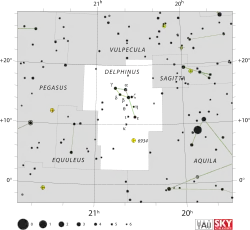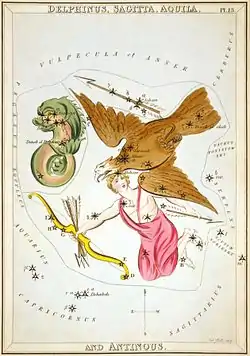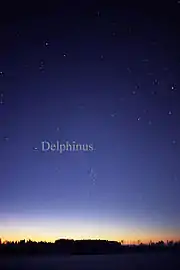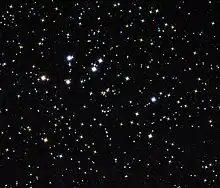Delphinus
Delphinus (Pronounced /dɛlˈfaɪnəs/ or /ˈdɛlfɪnəs/) is a small constellation in the Northern Celestial Hemisphere, close to the celestial equator. Its name is the Latin version for the Greek word for dolphin (δελφίνι). It is one of the 48 constellations listed by the 2nd century astronomer Ptolemy, and remains one of the 88 modern constellations recognized by the International Astronomical Union. It is one of the smaller constellations, ranked 69th in size. Delphinus' five brightest stars form a distinctive asterism symbolizing a dolphin with four stars representing the body and one the tail. It is bordered (clockwise from north) by Vulpecula, Sagitta, Aquila, Aquarius, Equuleus and Pegasus.
| Constellation | |
 | |
| Abbreviation | Del |
|---|---|
| Genitive | Delphini |
| Pronunciation | /dɛlˈfaɪnəs/ Delfínus, genitive /dɛlˈfaɪnaɪ/ |
| Symbolism | dolphin |
| Right ascension | 20h 14m 14.1594s to 21h 08m 59.6073s[1] |
| Declination | +2.4021468° to +20.9399471°[1] |
| Quadrant | NQ4 |
| Area | 189 sq. deg. (69th) |
| Main stars | 5 |
| Bayer/Flamsteed stars | 19 |
| Stars with planets | 5 |
| Stars brighter than 3.00m | 0 |
| Stars within 10.00 pc (32.62 ly) | 2 |
| Brightest star | Rotanev (β Del) (3.63m) |
| Messier objects | 0 |
| Meteor showers | None |
| Bordering constellations | Vulpecula Sagitta Aquila Aquarius Equuleus Pegasus |
| Visible at latitudes between +90° and −69°. Best visible at 21:00 (9 p.m.) during the month of September. | |
Delphinus is a faint constellation with only two stars brighter than an apparent magnitude of 4, Beta Delphini (Rotanev) at magnitude 3.6 and Alpha Delphini with a magnitude of 3.8.
Mythology

Delphinus is associated with two stories from Greek mythology.
According to the first Greek god Poseidon wanted to marry Amphitrite, a beautiful nereid. However, wanting to protect her virginity, she fled to the Atlas mountains. Her suitor then sent out several searchers, among them a certain Delphinus. Delphinus accidentally stumbled upon her and was able to persuade Amphitrite to accept Poseidon's wooing. Out of gratitude the god placed the image of a dolphin among the stars.[2][3]
The second story tells of the Greek poet Arion of Lesbos (7th century BC), who was saved by a dolphin.[4] He was a court musician at the palace of Periander, ruler of Corinth. Arion had amassed a fortune during his travels to Sicily and Italy. On his way home from Tarentum his wealth caused the crew of his ship to conspire against him. Threatened with death, Arion asked to be granted a last wish which the crew granted: he wanted to sing a dirge.[5] This he did, and while doing so, flung himself into the sea. There, he was rescued by a dolphin which had been charmed by Arion's music. The dolphin carried Arion to the coast of Greece and left.[6]
In non-Western astronomy
In Chinese astronomy, the stars of Delphinus are located within the Black Tortoise of the North (北方玄武, Běi Fāng Xuán Wǔ).[7]
In Polynesia, two cultures recognized Delphinus as a constellation. In Pukapuka, it was called Te Toloa and in the Tuamotus, it was called Te Uru-o-tiki.[8]
Characteristics
Delphinus is bordered by Vulpecula to the north, Sagitta to the northwest, Aquila to the west and southwest, Aquarius to the southeast, Equuleus to the east and Pegasus to the east.[1] Covering 188.5 square degrees, corresponding to 0.457% of the sky, it ranks 69th of the 88 constellations in size.[9] The three-letter abbreviation for the constellation, as adopted by the IAU in 1922, is "Del".[10] The official constellation boundaries, as set by Eugène Delporte in 1930, are defined by a polygon of 14 segments. In the equatorial coordinate system, the right ascension coordinates of these borders lie between 20h 14m 14.1594s and 21h 08m 59.6073s, while the declination coordinates are between +2.4021468° and +20.9399471°.[1] The whole constellation is visible to observers north of latitude 69°S.[9][lower-alpha 1]
Features


Stars
Delphinus has two stars above fourth (apparent) magnitude; its brightest star is of magnitude 3.6. The main asterism in Delphinus is Job's Coffin, nearly a 45°-apex lozenge diamond of the four brightest stars: Alpha, Beta, Gamma, and Delta Delphini. Delphinus is in a rich Milky Way star field. Alpha and Beta Delphini have 19th century names Sualocin and Rotanev, read backwards: Nicolaus Venator, the Latinized name of a Palermo Observatory director, Niccolò Cacciatore (d. 1841).[4]
Alpha Delphini is a blue-white hued main sequence star of magnitude 3.8, 241 light-years from Earth.
Beta Delphini, called Rotanev. The gap between its close binary stars is visible from large amateur telescopes. To the unaided eye, it appears to be a white star of magnitude 3.6. It has a period of 27 years and is 97 light-years from Earth.
Gamma Delphini is a celebrated binary star among amateur astronomers. The primary is orange-gold of magnitude 4.3; the secondary is a light yellow star of magnitude 5.1. The pair form a true binary with an estimated orbital period of over 3,000 years. 125 light-years away, the two components are visible in a small amateur telescope.[4] The secondary, also described as green, is 10 arcseconds from the primary. Struve 2725, called the "Ghost Double", is a pair that appears similar but dimmer. Its components of magnitudes 7.6 and 8.4 are separated by 6 arcseconds and are 15 arcminutes from Gamma Delphini itself.[6]
Delta Delphini is a type A7 IIIp star of magnitude 4.43.
Epsilon Delphini, Deneb Dulfim (lit. "tail [of the] Dolphin"), or Aldulfin, is a star of stellar class B6 III and magnitude 4, at 330 ly.[11]
Zeta Delphini, blue-white main-sequence star of magnitude 4.6, was in 2014 discovered to have a brown dwarf orbiting around it. Zeta Delphini B has a mass of 50±15 MJ.[12]
In Delphinus, in extremes of distance, Gliese 795 is the closest known star at 54.95 ly and rapidly moves east over a period of centuries (863±3 arcseconds per year); whereas the giant of blue colour, W Delphini is at 2203.81 ly at 9.76 magnitude.[11] Its brightness ranges from a magnitude of 12.3 to a magnitude of 9.7 over its variable period as it is a Beta Persei star-type semi-detached system. Other variable stars of large amateur telescopic visibility include R Delphini, a Mira-type variable star with a period of 285.5 days. Its magnitude ranges between a maximum 7.6 and a minimum 13.8.
Rho Aquilae at magnitude 4.94 is at about 150 light years.[13] Due to its proper motion it has been in the (round-figure parameter) bounds of the constellation since 1992.
HR Delphini was a nova that brightened to magnitude 3.5 in December 1967.[14] It took an unusually long time for the nova to reach peek brightness which indicate that it barely satisfied the conditions for a thermonuclear runaway.[15] Another nova by the name V339 Delphini was detected in 2013; it peaked at magnitude 4.3 and was the first nova observed to produce lithium.[16][17][18][19]
Musica, also known by its Flamsteed designation 18 Delphini, is one of the five stars with known planets located in Delphinus. Arion, the planet, is a very dense and massive planet with a mass at least 10.3 times greater than Jupiter.[20] Arion was part of the first NameExoWorlds contest where the public got the opportunity to suggest names for exoplanets and their host stars.[21]
Deep-sky objects
Its rich Milky Way star field means many modestly deep-sky objects. NGC 6891 is a planetary nebula of magnitude 10.5; another is NGC 6905 or the Blue Flash nebula. NGC 6934 is a globular cluster of magnitude 9.75. At a distance of about 185,000 light-years, the globular cluster NGC 7006 is at the outer reaches of the galaxy. It is also fairly dim at magnitude 11.5.
See also
Notes
Citations
- "Delphinus, Constellation Boundary". The Constellations. International Astronomical Union. Retrieved 15 July 2020.
- Pseudo-Hyginus. "HYGINUS, ASTRONOMICA 2.1-17". Theoi Classical Texts Library. Retrieved June 26, 2017.
- Ravensdale, Kaede. "Never Cry Werewolf".
- Ridpath & Tirion 2017, pp. 140-141.
- Herodotus, Histories I.23-24;
also Aulus Gellius, Noctes Atticae XVI.19; Plutarch, Conv. sept. sap. 160-62; Shakespeare, Twelfth Night (Act I, Sc 2, line 16) - Schaaf, Fred (September 2012). "The Celestial Dolphin". Sky and Telescope: 47.
- (in Chinese) AEEA (Activities of Exhibition and Education in Astronomy) 天文教育資訊網 2006 年 7 月 4 日
- Makemson 1941, p. 283.
- Ridpath, Ian. "Constellations: Andromeda–Indus". Star Tales. Self-published. Retrieved 4 March 2016.
- Russell, Henry Norris (1922). "The New International Symbols for the Constellations". Popular Astronomy. 30: 469. Bibcode:1922PA.....30..469R.
- http://www.universeguide.com/starsearch
- De Rosa, R. J.; Patience, J.; Ward-Duong, K.; Vigan, A.; Marois, C.; Song, I.; Macintosh, B.; Graham, J. R.; Doyon, R.; Bessell, M. S.; Lai, O.; McCarthy, D. W.; Kulesa, C. (December 2014). "The VAST Survey - IV. A wide brown dwarf companion to the A3V star ζ Delphini". Monthly Notices of the Royal Astronomical Society. 445 (4): 3694. Bibcode:2014MNRAS.445.3694D. doi:10.1093/mnras/stu2018. ISSN 0035-8711.
- Wielen, R.; et al. (1999), "Sixth Catalogue of Fundamental Stars (FK6). Part I. Basic fundamental stars with direct solutions", Veroeffentlichungen des Astronomischen Rechen-Instituts Heidelberg, Astronomisches Rechen-Institut Heidelberg, 35 (35): 1, Bibcode:1999VeARI..35....1W.
- Isles, J. E. (1974). "HR Delphini (Nova 1967) in 1967 - 71". Journal of the British Astronomical Association. 85: 54–58. Bibcode:1974JBAA...85...54I.
- Friedjung, M (17 March 1992). "The unusual nature of nova HR Delphini 1967". Astronomy & Astrophysics. 262 (262): 487. Bibcode:1992A&A...262..487F. Retrieved 19 July 2020.
- Tajitsu, Akito; Sadakane, Kozo; Naito, Hiroyuki; Arai, Akira; Aoki, Wako (18 February 2015). "Explosive lithium production in the classical nova V339 Del (Nova Delphini 2013)". Nature. 518 (7539): 381–384. arXiv:1502.05598. Bibcode:2015Natur.518..381T. doi:10.1038/nature14161. PMID 25693569. S2CID 205242345.
- King, Bob (August 14, 2013). "Bright New Nova In Delphinus — You can See it Tonight With Binoculars". Universe Today (initial designation PNV J20233073+2046041). Retrieved August 15, 2013.
- Guido, Ernesto; Ruocco, Nello; Howes, Nick (August 15, 2013). "Possible Bright Nova in Delphinus". Associazione Friulana di Astronomia e Meteorologia. Retrieved August 15, 2013.
- Masi, Gianluca (August 15, 2013). "Nova Delphini 2013 (formerly PNV J20233073+2046041): images, spectra and maps". Gianluca Masi - Virtual Telescope Project. Retrieved August 15, 2013.
- Sato, Bun’ei; Izumiura, Hideyuki; Toyota, Eri; Kambe, Eiji; Ikoma, Masahiro; Omiya, Masashi; Masuda, Seiji; Takeda, Yoichi; Murata, Daisuke; Itoh, Yoichi; Ando, Hiroyasu; Yoshida, Michitoshi; Kokubo, Eiichiro; Ida, Shigeru (25 June 2008). "Planetary Companions around Three Intermediate-Mass G and K Giants: 18 Delphini, ξ Aquilae, and HD 81688". Publications of the Astronomical Society of Japan. 60 (3): 539–550. arXiv:0802.2590. Bibcode:2008PASJ...60..539S. doi:10.1093/pasj/60.3.539. ISSN 0004-6264.
- "International Astronomical Union | IAU". www.iau.org. Retrieved 19 July 2020.
References
- Makemson, Maud Worcester (1941). The Morning Star Rises: an account of Polynesian astronomy. Yale University Press. Bibcode:1941msra.book.....M.
- Ian Ridpath and Wil Tirion (2017). Stars and Planets Guide, Collins, London. ISBN 978-0-00-823927-5. Princeton University Press, Princeton. ISBN 978-0-691-17788-5.
- University of Wisconsin, "Delphinus"
External links
| Wikimedia Commons has media related to Delphinus (constellation). |
